engine PONTIAC BONNEVILLE 1994 Service Manual
[x] Cancel search | Manufacturer: PONTIAC, Model Year: 1994, Model line: BONNEVILLE, Model: PONTIAC BONNEVILLE 1994Pages: 290, PDF Size: 14.75 MB
Page 160 of 290
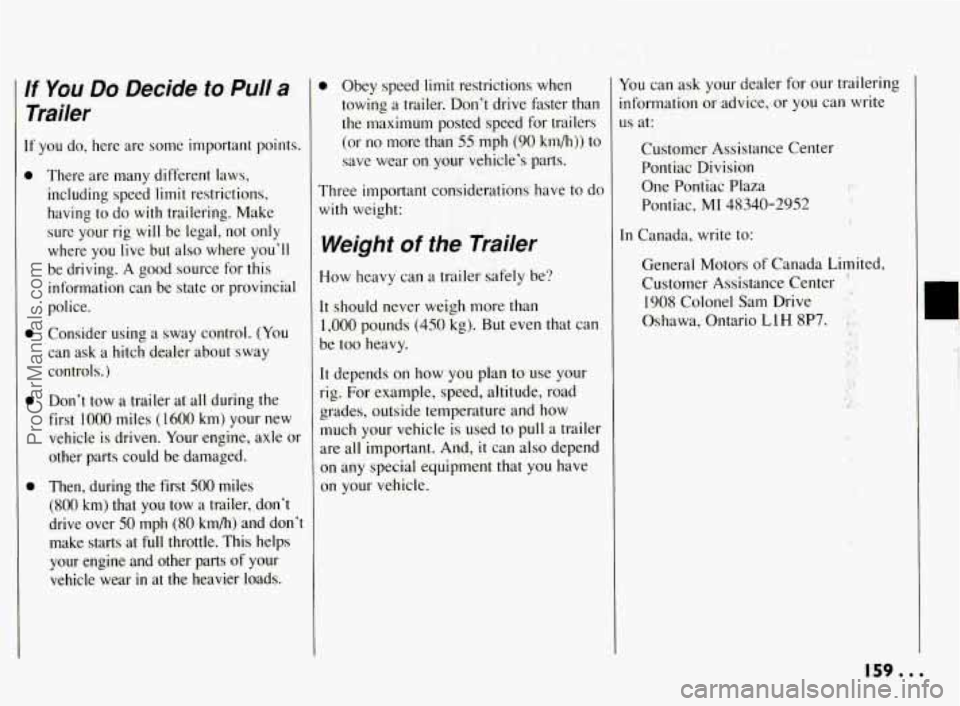
If You Do Decide to Pull a
Trailer
If you do, here are some important points.
0
0
There are many different laws,
including speed
limit restrictions,
having to do with trailering. Make
sure your rig
will be legal, not only
where you live but also where you'll
be
driving. A good source for this
information can
be state or provincial
police.
Consider using a sway control.
(You
can ask a hitch dealer about sway
controls.)
Don't tow a trailer at
all during the
first
1000 miles ( 1600 km) your new
vehicle is driven. Your engine, axle or
other parts could be damaged.
Then, during the first
500 miles
(800 km) that you tow a trailer, don't
drive over
50 mph (80 km/h) and don't
make starts at
full throttle. This helps
your engine and other parts of
your
vehicle wear in at the heavier loads.
0 Obey speed limit restrictions when
towing a trailer. Don't drive faster than
the maximum posted speed for trailers
(or no more than
55 mph (90 km/h)) to
save wear on your vehicle's parts.
Three important considerations have to do
with weight:
Weight of the Trailer
How heavy can a trailer safely be?
It should never weigh more than
1,000 pounds (450 kg). But even that can
be too heavy.
It depends on how you plan
to use your
rig. For example, speed, altitude, road
grades, outside temperature and how
much your vehicle is used to pull a trailer
are all important. And,
it can also depend
on any special equipment that you have
on your vehicle.
You can ask your dealer for our trailering
information or advice, or you can write
us at:
Customer Assistance Center
Pontiac Division
One Pontiac Plaza
Pontiac,
MI 48340-2952
In Canada, write to:
General Motors of Canada Limited,
Customer Assistance Center
1908 Colonel Sam Drive
Oshawa, Ontario
L 1 H 8P7. .:.).
':
>,
a~
l?': . '
. :*$' -.. I +. :Pm
.. ' i?',
-5%
159...
ProCarManuals.com
Page 163 of 290
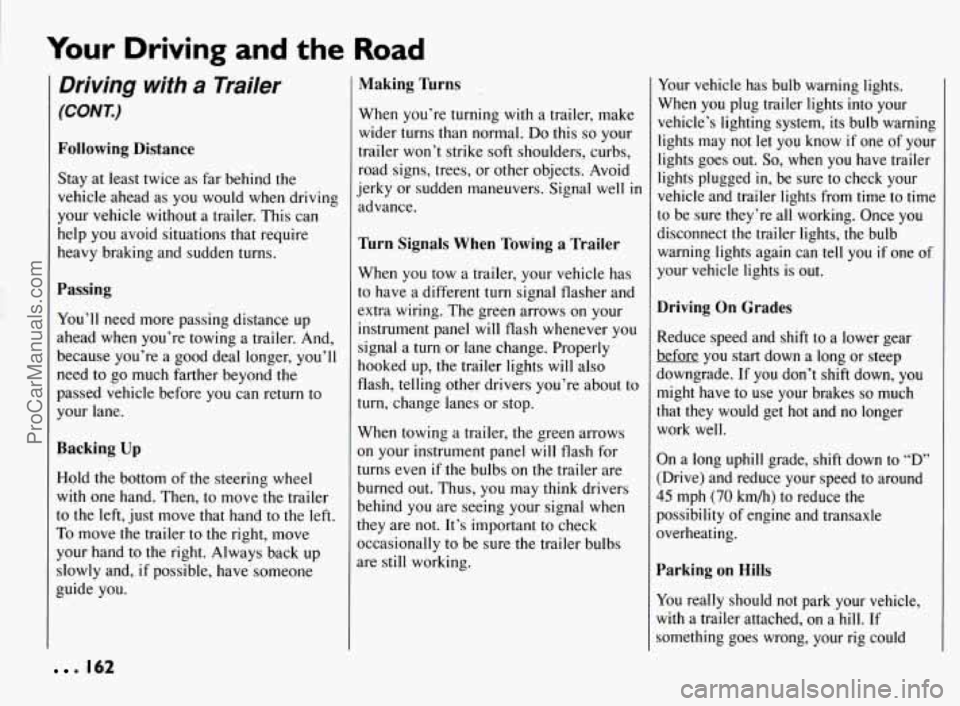
Your Driving and the Road
Driving with a Trailer
(CONT.)
Following Distance
Stay at least twice as far behind the
vehicle ahead as you would when driving
your vehicle without a trailer. This can
help you avoid situations that require
heavy braking and sudden turns.
Passing
You’ll need more passing distance up
ahead when you’re towing a trailer. And,
because you’re a good deal longer, you’ll
need to
go much farther beyond the
passed vehicle before you can return to
your lane.
Backing Up
Hold the bottom of the steering wheel
with one hand. Then, to move the trailer
to the left, just move that hand to the left.
To move the trailer to the right, move
your hand to the right. Always back up
slowly and,
if possible, have someone
guide you.
Making Turns
When you’re turning with a trailer, make
wider turns than normal. Do this
so your
trailer won’t strike soft shoulders, curbs,
road signs, trees, or other objects. Avoid
jerky or sudden maneuvers. Signal well
in
advance.
Turn Signals When Towing a Trailer
When you tow a trailer, your vehicle has
to have a different turn signal flasher and
extra wiring. The green arrows on your
instrument panel will flash whenever you
signal a turn or lane change. Properly
hooked up, the trailer lights will also
flash, telling other drivers you’re about to
turn, change lanes or stop.
When towing a trailer, the green arrows
on your instrument panel will flash for
turns even if the bulbs on the trailer are
burned out. Thus, you may think drivers
behind you are seeing your signal when
they are not. It’s important to check
occasionally to be sure the trailer bulbs
are still working. Your
vehicle has bulb warning lights.
When you plug trailer lights into your
vehicle’s lighting system, its bulb warning
lights may not let
you know if one of your
lights goes out.
So, when you have trailer
lights plugged
in, be sure to check your
vehicle and trailer lights from time
to time
to be sure they’re all working. Once you
disconnect the trailer lights, the bulb
warning lights again can tell you if one
of
your vehicle lights is out.
Driving On Grades
Reduce speed and shift to a lower gear
before you start down a long or steep
downgrade. If you don’t shift down, you
might have to use your brakes
so much
that they would get hot and no longer
work well.
On a long uphill grade, shift down to “D”
(Drive) and reduce your speed to around
45 mph (70 km/h) to reduce the
possibility
of engine and transaxle
overheating.
Parking on Hills
You really should not park your vehicle,
with a trailer attached, on a hill. If
something goes wrong, your rig could
. 162
ProCarManuals.com
Page 164 of 290
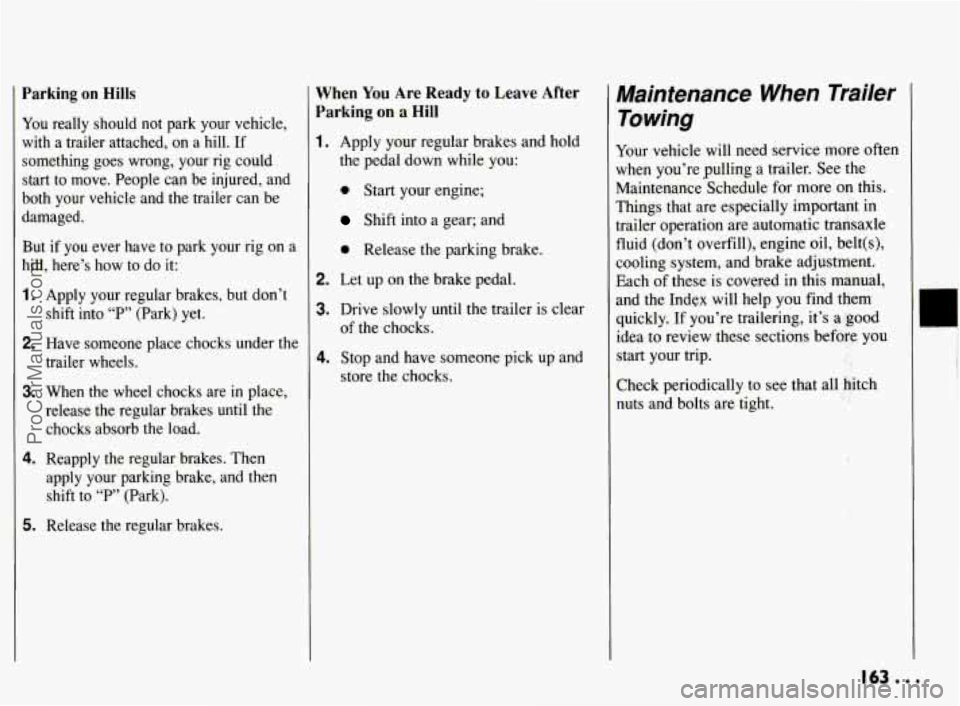
Parking on Hills
You really should not park your vehicle,
with a trailer attached, on a hill.
If
something goes wrong, your rig could
start to move. People can be injured, and
both your vehicle and the trailer can be
damaged.
But if you ever have to park your rig on a
hill, here’s how to do it:
1.
2.
3.
4.
5.
Apply your regular brakes, but don’t
shift into
“P” (Park) yet.
Have someone place chocks under the
trailer wheels.
When the wheel chocks are in place,
release the regular brakes until the chocks absorb the load.
Reapply the regular brakes. Then
apply your parking brake, and then shift to
“F”’ (Park).
Release the regular brakes.
When You Are Ready to Leave After
Parking
on a Hill
1.
2.
3.
4.
Apply your regular brakes and hold
the pedal down while you:
0 Start your engine;
Shift into a gear; and
0 Release the parking brake.
Let up on the brake pedal.
Drive slowly until the trailer is clear
of the chocks.
Stop and have someone pick up and
store the chocks.
Maintenance When Trailer Towing
Your vehicle will need service more often
when you’re pulling a trailer.
See the
Maintenance Schedule for more
on this.
Things that are especially important in
trailer operation are automatic transaxle
fluid (don’t overfill), engine oil, belt(s),
cooling system, and brake adjustment,
Each
of these is covered in this manual,
and the Index will help you find them
quickly. If you’re trailering, it’s a good
idea to review these sections before. you
start your trip.
Check periodically to
see that all hitch
nuts and bolts are tight.
,j.;
i .a
1. i
,
.?.
163...
ProCarManuals.com
Page 166 of 290
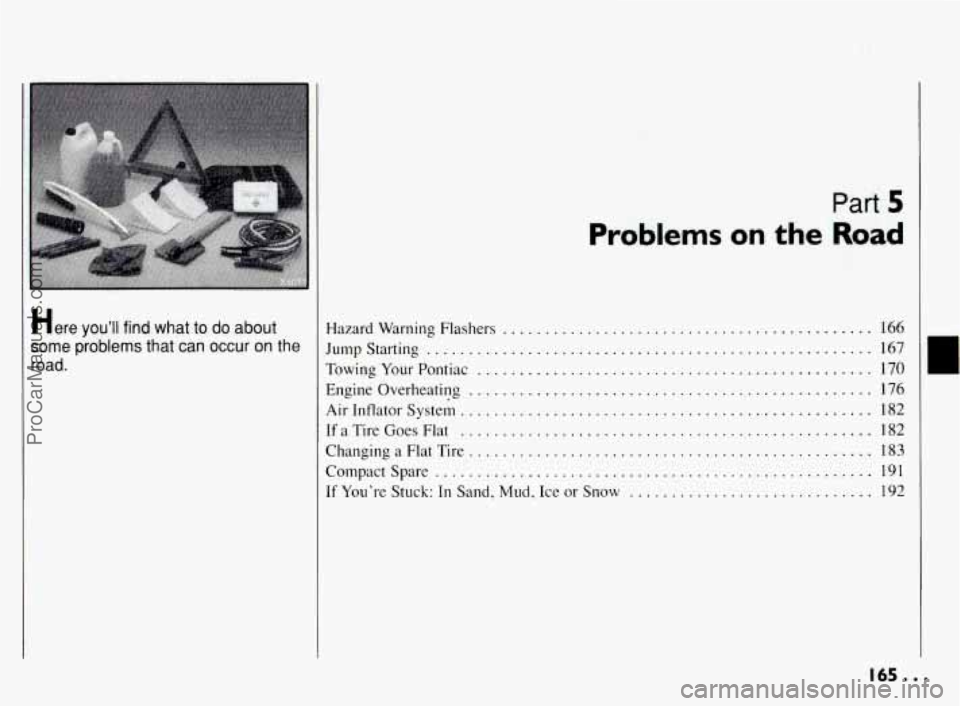
Here you'^^ find what to do about
some problems that can occur on the
road .
Problems on the
Part. 5
Hazard Warning Flashers ............................................
TowingYourPontiac ...............................................
EngineOverheating ................................................
Air Inflator System .................................................
If a Tire Goes Flat .................................................
ChangingaFlatTire ................................................
CompactSpare ....................................................
If You're Stuck: In Sand. Mud. Ice or Snow .... ......................
Jump Starting .....................................................
1;66
167
170
k76
182
182
183
191
192
165 .
ProCarManuals.com
Page 169 of 290
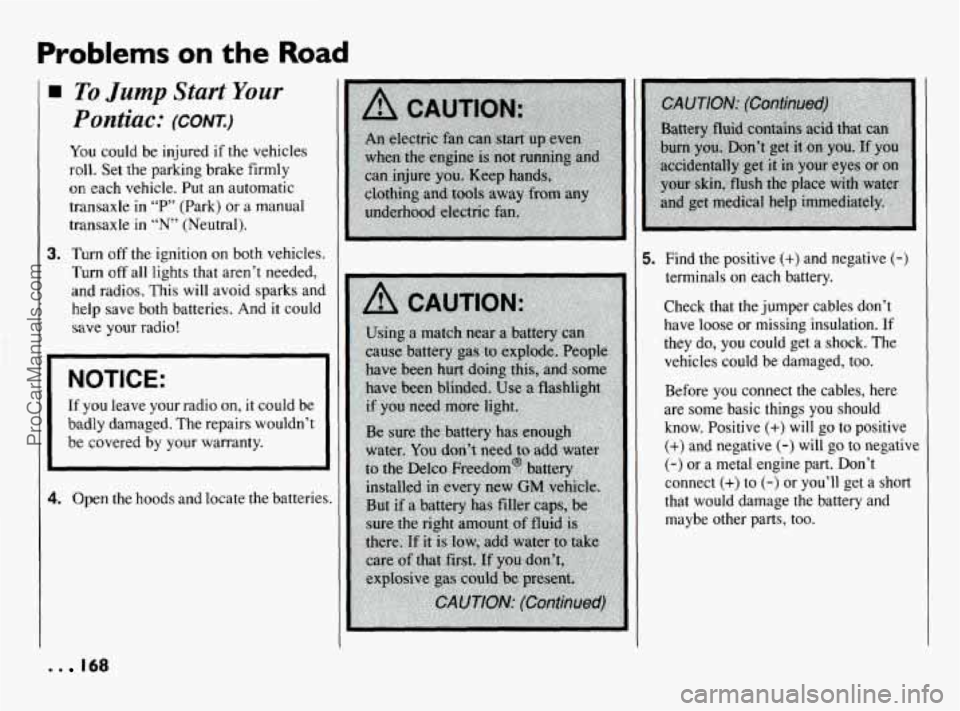
Problems on the Road
To Jump Start Your
Pontiac: (CONK)
You could be injured if the vehicles
roll. Set the parking brake firmly
on each vehicle. Put an automatic
transaxle
in “P” (Park) or a manual
transaxle
in “N” (Neutral).
3. Turn off the ignition on both vehicles.
Turn
off all lights that aren’t needed,
and radios. This will avoid sparks and
help save both batteries. And
it could
save your radio!
NOTICE:
~ ~~ ~~
If you leave your radio on, it could be
badly damaged. The repairs wouldn’t
be covered by your warranty.
4. Open the hoods and locate the batteries.
5. Find the positive (+) and negative (-)
terminals on each battery.
Check that
the jumper cables don’t
have loose or missing insulation. If
they do, you could get a shock. The
vehicles could be damaged, too.
Before you connect the cables, here
are some basic things you should
know. Positive
(+) will go to positive
(+) and negative (-) will go to negative
(-) or a metal engine part. Don’t
connect
(+) to (-) or you’ll get a short
that would damage the battery and maybe other parts, too.
. . 168
ProCarManuals.com
Page 170 of 290
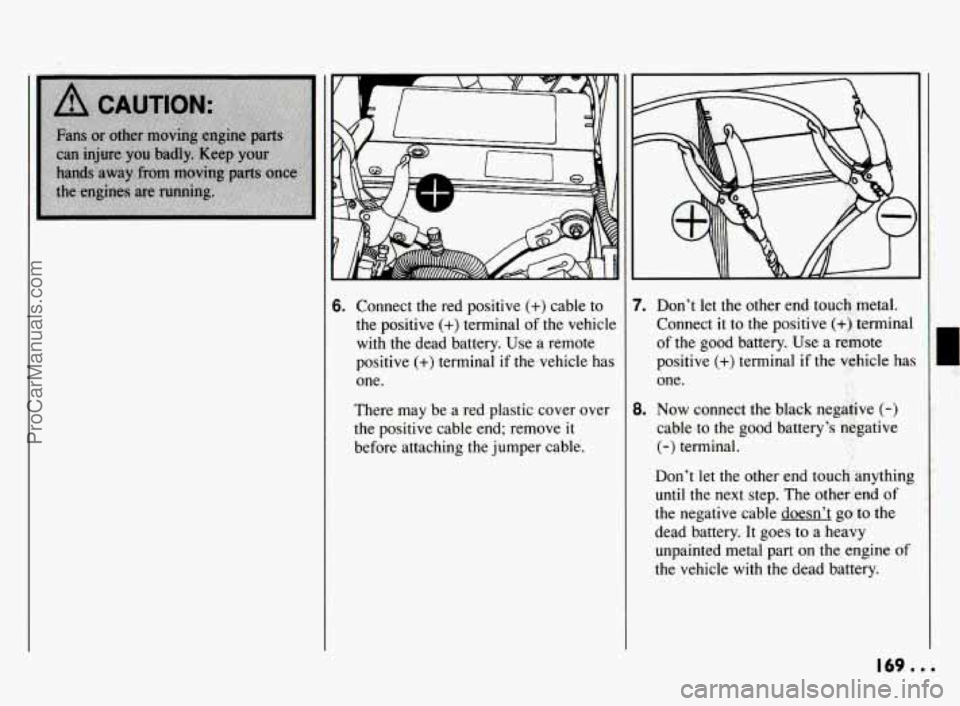
6. Connect the red positive (+) cable to
the positive (+) terminal of the vehicle
with the dead battery. Use a remote
positive
(+) terminal if the vehicle has
one.
There may be a red plastic cover over
the positive cable end; remove
it
before attaching the jumper cable.
7. Don’t let the other end touch metal.
Connect it to the positive
(+) terminal
of the good battery. Use a remote
positive
(+) terminal if the vehicle has
one.
8. Now connect the black negative (-)
cable to the good battery’s negative
(-) terminal.
Don’t let the other end touch anything
until the next step. The other end of
the negative cable doesn’t go to the
dead battery. It goes to a heavy
unpainted metal part
on the engine of
the vehicle with
the dead battery.
169...
ProCarManuals.com
Page 171 of 290
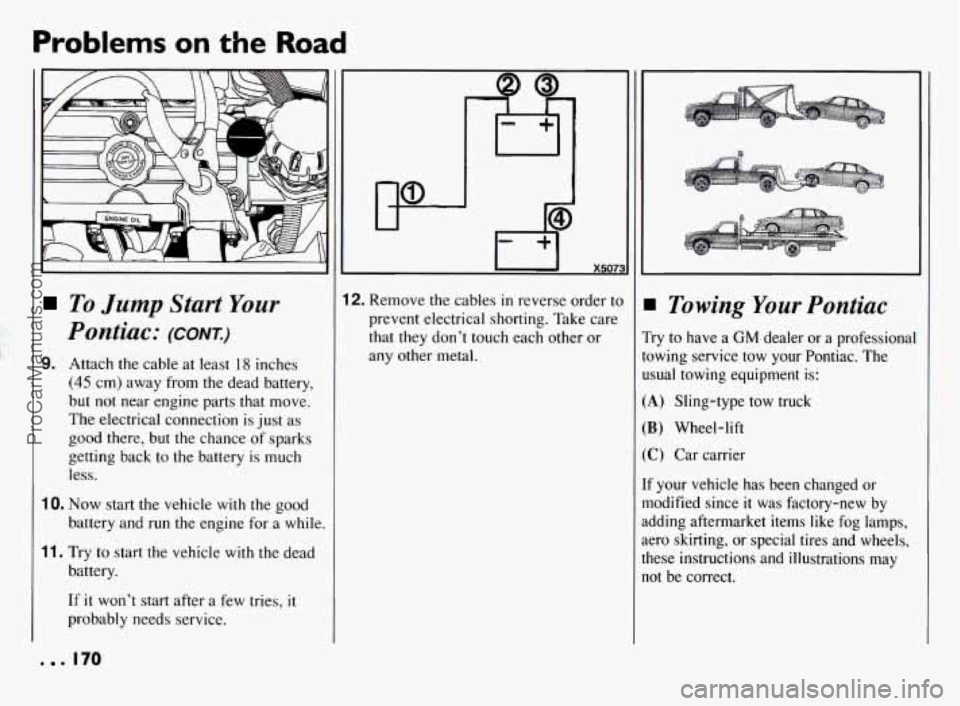
Problems on the Road
To Jump Start Your
Pontiac: (CONT.)
9. Attach the cable at least 18 inches
(45 cm) away from the dead battery,
but not near engine parts that move.
The electrical connection is just as
good there, but the chance of sparks
getting back to the battery is much
less.
16. Now start the vehicle with the good
battery and
run the engine for a while.
11. Try to start the vehicle with the dead
battery.
If it won't start after a few tries, it
probably needs service.
I 0 170
12. Re'move the cables in reverse order to
prevent electrical shorting. Take care
that they don't touch each other or
any other metal. Towing Your Pontiac
Try to have a GM dealer or a professional
towing service tow your Pontiac. The
usual towing equipment is:
(A) Sling-type tow truck
(B) Wheel-lift
(C) Car carrier
If your vehicle has been changed or
modified since it was factory-new by
adding aftermarket items like fog lamps,
aero skirting, or special tires and wheels,
these instructions and illustrations may
not be correct.
ProCarManuals.com
Page 177 of 290
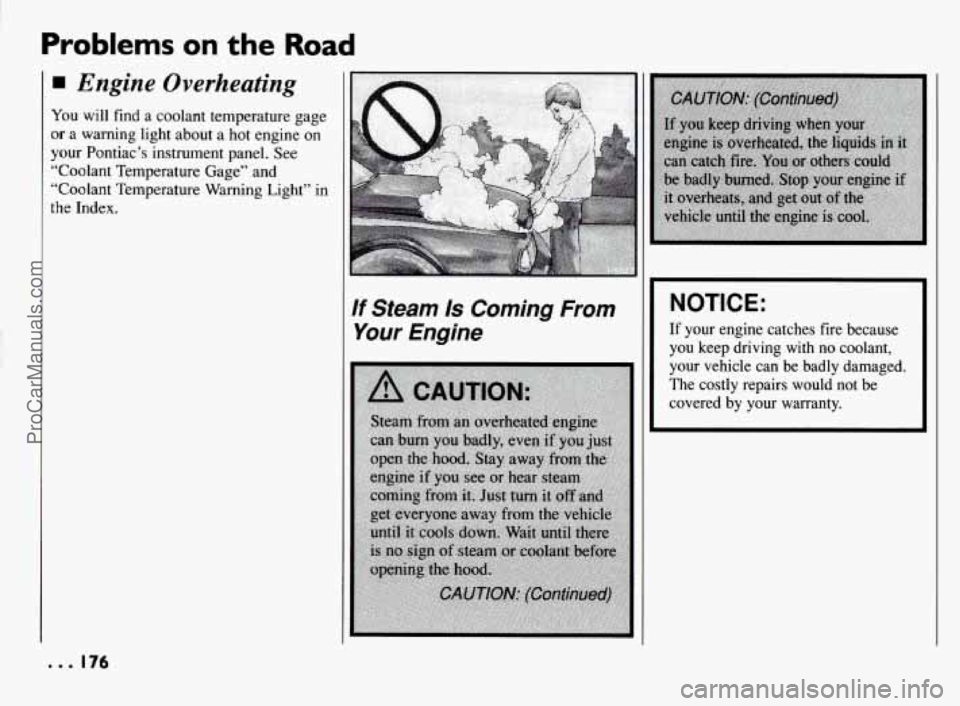
Problems on the Road
H Engine Overheating
You will find a coolant temperature gage
or a warning light about a hot engine on
your Pontiac’s instrument panel. See
“Coolant Temperature Gage” and
“Coolant Temperature Warning Light” in
the Index.
If Steam Is Coming From
Your Engine
NOTICE:
If your engine catches fire because
you keep driving with no coolant,
your vehicle can be badly damaged.
The costly repairs would not be
covered by your warranty.
ProCarManuals.com
Page 178 of 290
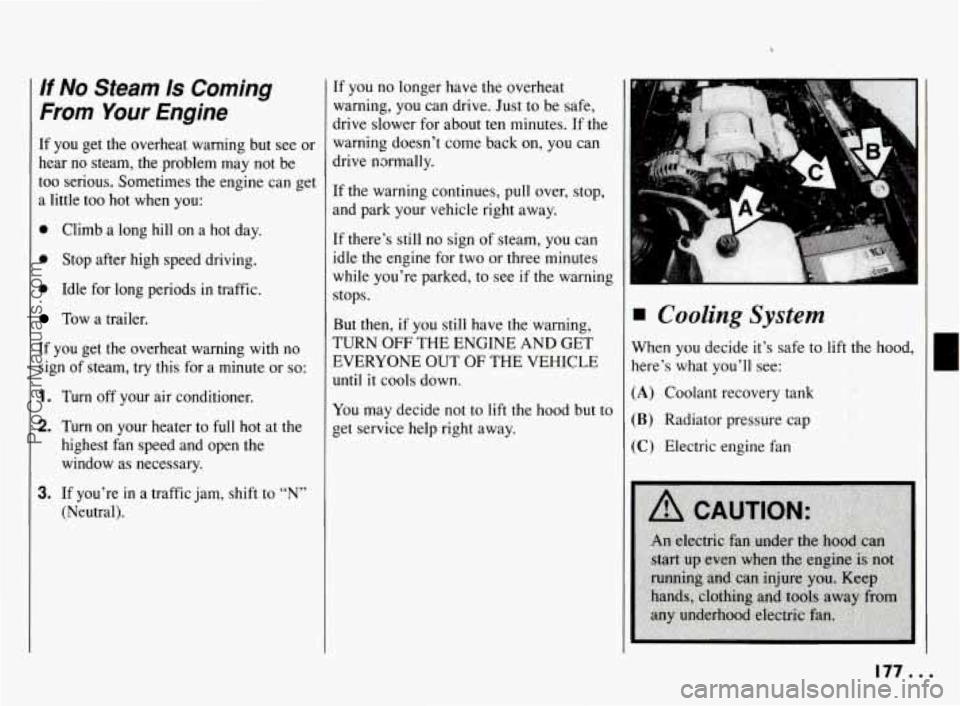
If No Steam Is Coming
From Your Engine
If you get the overheat warning but see or
hear no steam, the problem may not be
too serious. Sometimes the engine can get
a little too hot when you:
0 Climb a long hill on a hot day.
0 Stop after high speed driving.
0 Idle for long periods in traffic.
Tow a trailer.
If you get the overheat warning with
no
sign of steam, try this for a minute or so:
1. Turn off your air conditioner.
2. Turn on your heater to full hot at the
highest fan speed and open the
window as necessary.
3. If you’re in a traffic jam, shift to “N”
(Neutral).
If you no longer have the overheat
warning, you can drive. Just to be safe,
drive slower for about ten minutes. If the
warning doesn’t come back on, you can
drive normally.
If the warning continues, pull over, stop,
and park your vehicle right away.
If there’s still no sign of steam, you can
idle the engine for two or three minutes
while you’re parked, to see
if the warning
stops.
But then,
if you still have the warning,
TURN
OFF THE ENGINE AND GET
EVERYONE OUT
OF THE VEHICLE
until it cools down.
You may decide not to lift the hood but to
get service help right away.
11
Cooling System
When you decide it’s safe to lift the hood,
here’s what you’ll see:
(A) Coolant recovery tank
(B) Radiator pressure cap
(C) Electric engine fan
. 177..
c
ProCarManuals.com
Page 179 of 290
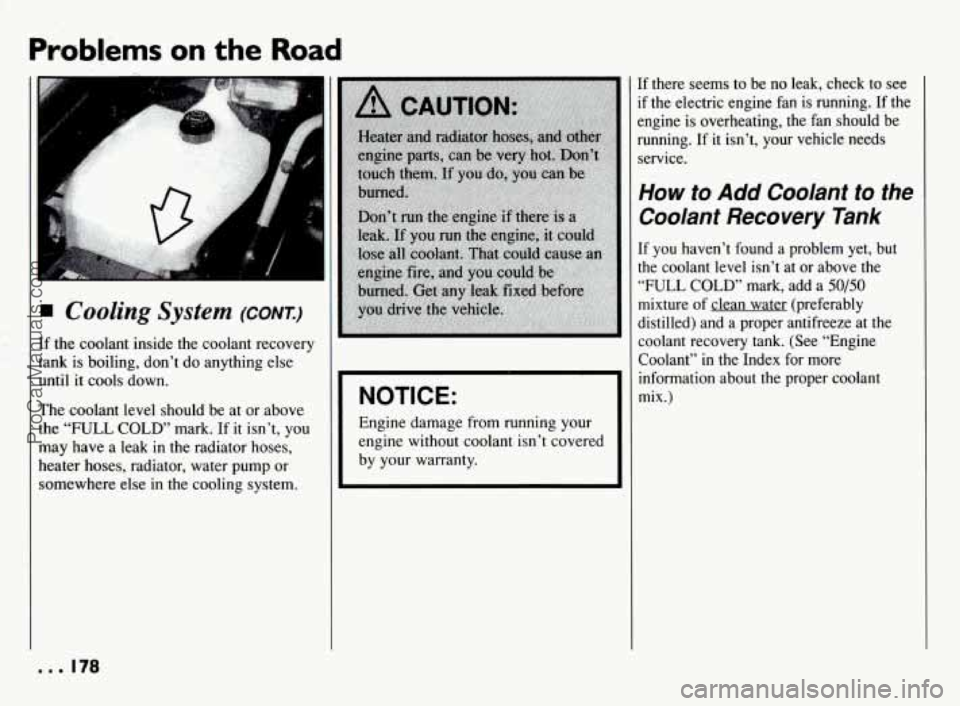
Problems on the Ro,ad
... .
I
Cooling System (CONT.)
If the coolant inside the coolant recovery
tank is boiling, don’t do anything else
until it cools down.
The coolant level should be at or above
the “FULL COLD’ mark. If
it isn’t, you
may have a leak
in the radiator hoses,
heater hoses, radiator, water pump or
somewhere else in the cooling system.
NOTICE:
Engine damage from running your
engine without coolant isn’t covered
by your warranty.
If there seems to be no leak, check to see
if the electric engine fan is running. If the
engine
is overheating, the fan should be
running. If it isn’t, your vehicle needs
service.
How to Add Coolant to the
Coolant Recovery Tank
If you haven’t found a problem yet, but
the coolant level isn’t
at or above the
“FULL COLD’ mark, add
a 50/50
mixture of clean water (preferably
distilled) and
a proper antifreeze at the
coolant recovery tank. (See “Engine Coolant”
in the Index for more
information about the proper coolant
mix.)
... 178
ProCarManuals.com